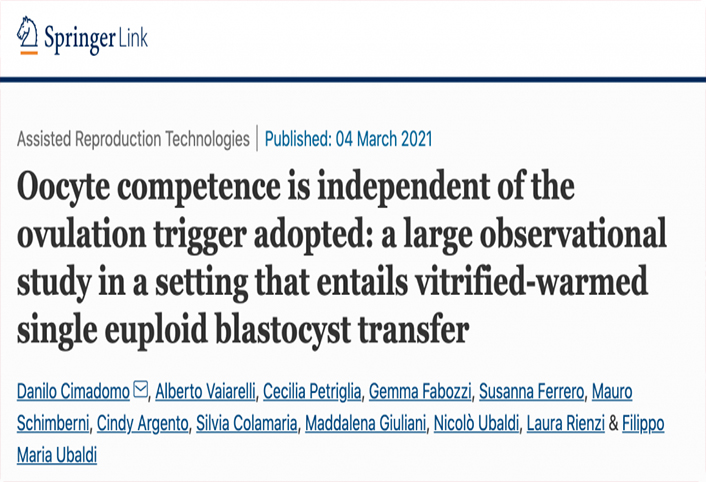
Oocyte competence is independent of the ovulation trigger adopted: a large observational study in a setting that entails vitrified-warmed single euploid blastocyst transfer
Danilo Cimadomo, Alberto Vaiarelli, Cecilia Petriglia, Gemma Fabozzi, Susanna Ferrero, Mauro Schimberni, Cindy Argento, Silvia Colamaria, Maddalena Giuliani, Nicolò Ubaldi, Laura Rienzi & Filippo Maria Ubaldi
Journal of Assisted Reproduction and Genetics, Published: 04 March 2021
Abstract
Purpose: To assess whether the GnRH-agonist or urinary-hCG ovulation triggers affect oocyte competence in a setting entailing vitrified-warmed euploid blastocyst transfer.
Methods: Observational study (April 2013–July 2018) including 2104 patients (1015 and 1089 in the GnRH-a and u-hCG group, respectively) collecting ≥1 cumulus-oocyte-complex (COC) and undergoing ICSI with ejaculated sperm, blastocyst culture, trophectoderm biopsy, comprehensive-chromosome-testing, and vitrified-warmed transfers at a private clinic. The primary outcome measure was the euploid-blastocyst-rate per inseminated oocytes. The secondary outcome measure was the maturation-rate per COCs. Also, the live-birth-rate (LBR) per transfer and the cumulative-live-birth-delivery-rate (CLBdR) among completed cycles were investigated. All data were adjusted for confounders.
Results: The generalized-linear-model adjusted for maternal age highlighted no difference in the mean euploid-blastocyst-rate per inseminated oocytes in either group. The LBR per transfer was similar: 44% (n=403/915) and 46% (n=280/608) in GnRH-a and hCG, respectively. On the other hand, a difference was reported regarding the CLBdR per oocyte retrieval among completed cycles, with 42% (n=374/898) and 25% (n=258/1034) in the GnRh-a and u-hCG groups, respectively. Nevertheless, this variance was due to a lower maternal age and higher number of inseminated oocytes in the GnRH-a group, and not imputable to the ovulation trigger itself (multivariate-OR=1.3, 95%CI: 0.9–1.6, adjusted p-value=0.1).
Conclusion: GnRH-a trigger is a valid alternative to u-hCG in freeze-all cycles, not only for patients at high risk for OHSS. Such strategy might increase the safety and flexibility of controlled-ovarian-stimulation with no impact on oocyte competence and IVF efficacy.

